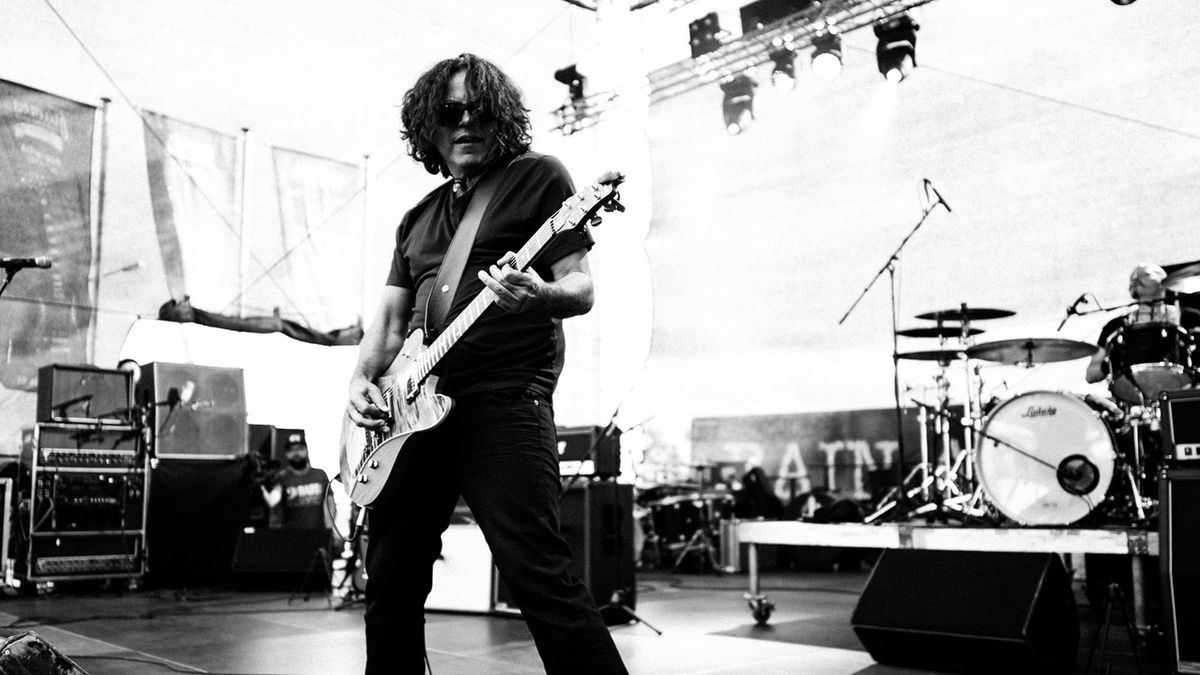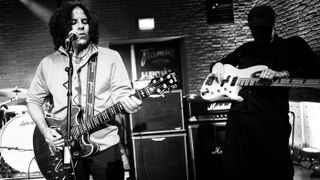One for the road - Stevie Salas: "Don’t be afraid of distortion; the cleanness comes from how you pick it out"
Bill & Ted, stage rigs and inspecting Angus's amp stack

The hands that made Bill & Ted’s Excellent Adventure even more excellent - Stevie Salas - expresses a fondness for high-end tequila…
Who have you gigged with?
“A few years out of high school, I got signed to Island Records and made my first album, Stevie Salas Colorcode [1990]. I became a music director for Terence Trent D’Arby and was Rod Stewart’s lead guitar player. I made records and played with the likes of Justin Timberland, TI, Public Enemy, Parliament Funkadelic and Michael Hutchence.
“I was a music director for American Idol for four seasons. I was a music director for Chris Daughtry, Adam Lambert, David Cook, Jordan Sparks and Kris Allen. And I was a music director and guitar player for Mick Jagger when he went solo.”
George Carlin and I wore the same outfit - they shot him from the neck up and me from the neck down
“I scored the movie Bill & Ted’s Excellent Adventure, and it’s my hands at the end doing the solos. I did the whole guitar score, as well as that crazy solo at the end. George Carlin and I wore the same outfit - they shot him from the neck up and me from the neck down.”
Describe your current stage rig…
“Well, what I’ve been using lately on tour is my [Framus] Idolmaker guitars. I came to Framus a few years ago. I was endorsing other companies, I’ve had a lot of different signature models over the last 20 years, and I was just kind of cruising around. It’s hard to create anything, and there are so many amazing guitars already. So, how do you do something that’s original and actually stands out? That’s the hardest thing, creating an original shape that just isn’t something that’s bananas, you know? Something just crazy or whacky.
Get the MusicRadar Newsletter
Want all the hottest music and gear news, reviews, deals, features and more, direct to your inbox? Sign up here.
“Most of [the Idolmakers] are made with mahogany bodies, maple tops, maple necks, with Seymour Custom Custom pickups - which is the pickup I’ve used forever in the back - and I like to find these Bill Lawrence Single Blades when I can. They’re vintage, you know, they’re hard to find now, and I’ve been using those forever - or I use Fat Cats. I’m experimenting with some Lollars, I’m experimenting with some of those Supro pickups.
“For amps, I’ve got a guy in Italy who makes my overdrive pedals and makes them for Phil X, too. It’s LAA Custom, and he makes some of my amps, and he just built me an amp that sounds like a ’65 Fender Deluxe Reverb that’s pretty amazing, that I blend in with Marshalls or, this last tour, I was using some Bognor Ecstasy heads, and sometimes I used some Diamond heads mixed with the LAA Custom because I like a bit of a cleaner rock-funk. You know, I prefer the AC/DC clean distortion than somebody’s super fuzzy distortion.”

What’s on your rider?
“My rider would probably just be a bottle of really, really high-end tequila. That’s all I really care about. That’s about it. I don’t really give a shit about too much other stuff. I’m not such a diva, but I do like a good tequila!”
Can you share your best tip for getting a live sound?
“You know, the key I think is that the sound comes from the hands, I really believe that, but I don’t like a lot of… I used to call it ‘bedroom sound’. You know, you’d do this sound in your bedroom that sounded like you were playing a sports arena. But then that kind of sound, when you’re in a sports arena, doesn’t cut. You have to find a way to have a clear, cutting tone that reaches the back of the room, right? I’d advise people to not be afraid of distortion.
I was opening for AC/DC in 2003, and Angus had 16 cabinets and eight 100-watt Super Lead heads on stage... all plugged in
“When I played with George Clinton, everyone always thinks those were direct guitars, but there’s a lot of distortion on there. So, I’d often just take a Marshall or something, and I’d back my volume down a little. So, it’s dirtier than you think, but the cleanness comes from how you pick it out. Because when you make it too clean, by the time it gets through the speaker of your recording, or the speaker of your live concert, especially in a big hall, it becomes glass thin, right? So, don’t be afraid of distortion, but don’t use too much distortion where it’s too muddy.
“I’ll tell you a story. I was opening for The Rolling Stones and AC/DC in 2003, and Angus had 16 cabinets and eight 100-watt Super Lead heads on stage, so I told this tech, ‘You’re full of shit. How many do you actually have going?’ He said, ‘All of them’. I go, ‘Bullshit,’ and he walked me through every cable, and I’ll be damned. He had all eight heads in 16 cabinets, all plugged in. You know, to each his own, and that sound was killing, but not everybody could do that. His sound is distorted, but really clear.”
What’s your advice for getting the audience on your side?
“Don’t suck!”
What’s the best venue you’ve played?
“I really liked the Budokan in Japan, but Madison Square Garden… I’ve played Madison Square Garden seven times. Certain venues like that, you actually count. Like, I’ve played the Forum nine times. I’ve played Madison Square Garden seven times, and when I first played Madison Square Garden, I walked onto the stage at soundcheck, got on my knees and kissed the stage, because it was like a dream to make it to Madison Square Garden, you know?
“So, I would have to say playing the Garden, playing the LA Forum, playing the San Diego Sports Arena because it was my hometown arena where I saw so many great concerts growing up, and playing, maybe, the Budokan.”

“This golden gain machine covers the entire spectrum from gritty boost through to full-on fuzz”: Great Eastern FX’s Focus Fuzz Deluxe has got boost, drive, octave, fuzz... everything going on

“This is the only tremolo pedal in the world that lets you plot your own waveform shapes using controls you first got to grips with as a child”: SoundLad Sketchy review










